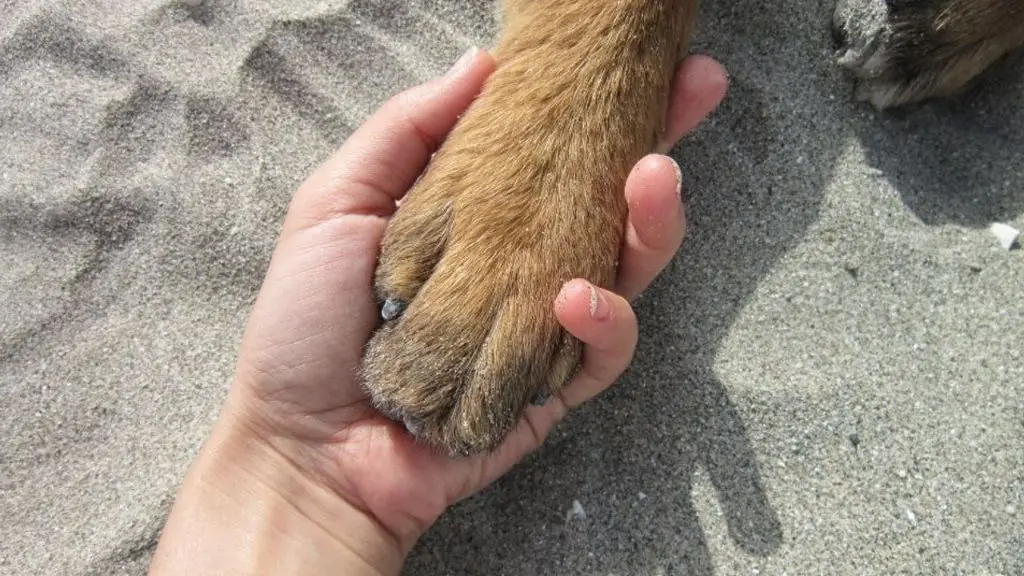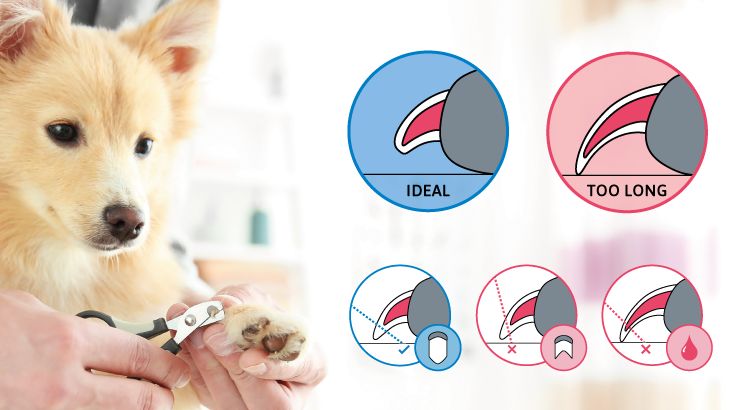Why Dogs May Bite When Their Paws Are Touched
Some dogs may bite or snap when their paws are touched due to fear, touch sensitivity, or past negative experiences associated with having their paws handled. This paw-biting reaction is often a defense mechanism because the dog feels threatened by having their feet touched.
Many dogs are sensitive about their paws being touched. The paws contain many nerve endings and are vulnerable, so dogs instinctively want to protect them. Additionally, dogs rely on their paws for balance and locomotion, so interfering with their paws can make them feel insecure.
Traumatic events like getting paws caught or injured, improper trimming of nails, or rough handling as a puppy can also cause a dog to develop negative associations with paw handling. This can lead them to react defensively and bite when their paws are touched, even if the intention is friendly.
Overall, biting when paws are touched stems from the dog feeling fearful and vulnerable. It’s a protective impulse that originates from fear, touch sensitivity, or past negative experiences related to their paws being handled.
Determine the Underlying Cause

There are often underlying reasons why dogs may try to bite when their paws are touched. It’s important to carefully observe and take note of the circumstances that trigger this behavior. What was happening right before the bite attempts? Was the dog sleeping or chewing a toy? Did the bite seem like a fearful reaction or a warning? Keeping detailed notes can help identify patterns and potential causes.
Schedule a veterinary exam to rule out injury or illness as a reason for paw sensitivity. Dogs in pain will often react defensively to touch, even from their trusted owners. The vet can also check for skin allergies, parasites, embedded foreign objects, orthopedic issues, and more that may be provoking the biting response.
Additionally, consider your dog’s breed traits. Herding breeds tend to be more sensitive about their paws, while terriers are often defensive of their personal space. Knowing your dog’s genetic predispositions provides insight into why they may react negatively to paw handling. The key is determining the root cause of the behavior, then addressing it through proper training techniques.
Desensitization Training
One of the most effective ways to get your dog comfortable with having his paws touched is through desensitization training. This involves slowly and gradually exposing your dog to having his paws handled, while ensuring the experience remains positive through treats and praise.

Start by simply placing your hand near your dog’s paw without actually touching it. Reward him with a treat and verbal praise for remaining calm. Slowly get closer over multiple training sessions until you can briefly touch his paws without a negative reaction. Provide treats immediately after touching his paw so he associates this handling with something positive.
As your dog becomes more comfortable, gradually increase the amount of time you are touching his paws. You can also begin gently manipulating his paws and toes. Continue to reassure him with treats and affection. Over time, he will learn that having his paws touched brings good things and doesn’t need to be scary.
Remain patient and don’t move too quickly through the desensitization process. Allowing your dog to become anxious or overwhelmed will be counterproductive. Go at your dog’s pace and keep sessions positive. With consistency, he will become more comfortable with paw handling.
Provide Alternatives to Biting
One of the best ways to curb biting is to provide your dog with acceptable alternatives that satisfy their natural urge to chew and bite. Having a variety of chew toys on hand will give your dog an appropriate outlet whenever they feel compelled to bite.
Rotate different chew toys to keep your dog interested. Offer toys made of nylon, rubber, or rope that can withstand aggressive chewing. Stick to larger toys that cannot be swallowed to avoid choking hazards.
You can also teach your dog the “drop it” command, which signals them to release whatever is in their mouth. Practice this command frequently by offering treats in exchange for dropped items. Eventually your dog will learn to relinquish objects on cue, rather than biting down harder.
Having an arsenal of chew toys on hand and training the “drop it” command provides acceptable alternatives for your dog to bite, chew, and express natural behaviors, while also respecting your space and hands as off limits.
Use Proper Handling Techniques
When handling your dog’s paws, avoid using restraint or force. Forcing your dog into unwanted contact can increase anxiety and make them more likely to bite. Instead, let your dog initiate paw contact on their own terms. Present your hand in a relaxed, open position and allow them to sniff and explore at their own pace.

Additionally, pay close attention to your dog’s body language. Signs of anxiety like lip licking, yawning, whale eye, and tense muscles indicate you should slow down or stop. If your dog is willingly relaxing into contact, offer praise and treats to reinforce the behavior. But the moment they show discomfort, give them space immediately. With time and positive reinforcement, your dog will gain confidence with having their paws handled gently.
Consider Muzzle Training
Muzzle training can be useful in some cases to ensure safety when handling a dog that bites. Introducing a muzzle should be done slowly and positively, allowing the dog to get comfortable wearing it. Start by letting your dog inspect and sniff the muzzle, then reward with treats for any positive interaction with it. Place the muzzle briefly on your dog’s nose and immediately give treats and praise. Slowly increase the duration your dog wears the muzzle, continuing to reward calm behavior. Only leave the muzzle on for short periods at first, like 30 seconds, then gradually build up the time wearing it. Make the experience fun by giving your dog their favorite treats and toys while muzzled. With patience, you can condition your dog to willingly wear a muzzle for handling and veterinary exams when needed.
Check for Pain or Injury
One possible reason your dog may bite when you touch his paws is that he is experiencing pain or discomfort. Carefully inspect your dog’s paws to check for any visible injuries, redness, irritation, swelling, foreign objects lodged between toes, etc. Gently palpate each paw to identify any sensitive areas. If your dog shows signs of pain or you discover an injury, schedule an appointment with your veterinarian right away. Treatment for the underlying condition can help resolve the biting behavior.
Dogs have complex nerve endings in their paws and are sensitive to touch there. If your dog has strained muscles, arthritis, joint issues or other medical problems involving his legs or paws, touching this area may cause pain or irritation. Have your vet do a thorough exam to diagnose and treat any physical conditions that could be making your dog nip when his paws are handled.
Getting to the root cause of the discomfort and providing medical care can help stop the biting reaction. Be especially diligent about checking your dog’s paws regularly to avoid situations where discomfort goes unnoticed.
When to Seek Professional Help
While biting can often be addressed through training, some severe cases may require intervention from a professional dog trainer or veterinary behaviorist. If biting and aggression persists despite consistent desensitization training and management techniques, it’s important to enlist professional help.
Signs that the issue requires professional support include biting that breaks skin, causes bruising or is clearly motivated by aggression rather than fear. Persistent lunging, growling or biting even during training sessions indicates an elevated risk. Additionally, any sudden behavior changes or new-onset aggression warrant an exam by your veterinarian to check for underlying medical issues that could be causing pain and irritability.
A professional trainer or veterinary behaviorist can conduct a full behavioral evaluation and develop an individualized modification plan. Prescription anti-anxiety medication or stress-reducing supplements may be recommended in some cases. With expert guidance tailored to your dog’s unique needs, biting and aggression issues can be overcome.
Prevention Tips
To help prevent your dog from biting when his paws are touched, follow these proactive tips:
Regular nail trims – Keep your dog’s nails trimmed to a proper length. Overgrown nails can cause discomfort and make your dog more sensitive about having his paws handled.

Massage paws during play – Gently squeeze and massage your dog’s paws during playtime or when he’s relaxed. This can help desensitize him to having his paws touched. Reward him with treats for calm behavior.
The Importance of Patience and Safety
When working to change any undesirable behavior in dogs, including biting when their paws are touched, it’s important to proceed with patience, care, and safety in mind. After all, change takes time. Dogs don’t understand that we’re trying to help them – they just experience fear or discomfort in the moment. As frustrating as it may be, avoid any punishment or retaliation when your dog bites or growls. This will only erode trust and make the problem worse. Instead, stay calm and focus on rebuilding your bond through positive interactions.
Work at your dog’s pace and keep training sessions short, rewarding generously when your dog allows handling. With time and consistency, most dogs can learn to accept paw handling and examinations. But the process relies heavily on trust between owner and dog. Avoid scolding or scaring your dog. Make training feel safe and focus on praise and treats. With a patient, trust-based approach, you can help your dog become more comfortable with paw handling over time.